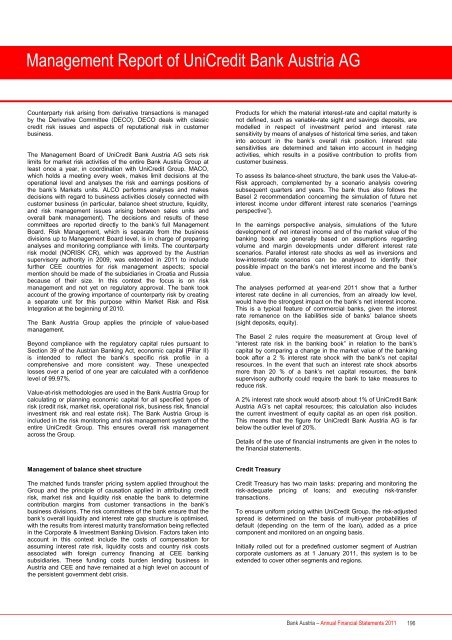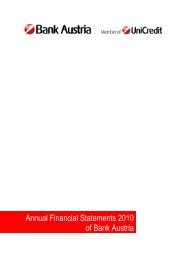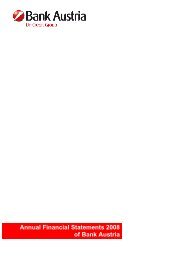Annual Financial Statements 2011 of Bank Austria
Annual Financial Statements 2011 of Bank Austria
Annual Financial Statements 2011 of Bank Austria
You also want an ePaper? Increase the reach of your titles
YUMPU automatically turns print PDFs into web optimized ePapers that Google loves.
Management Report <strong>of</strong> UniCredit <strong>Bank</strong> <strong>Austria</strong> AG<br />
Counterparty risk arising from derivative transactions is managed<br />
by the Derivative Committee (DECO). DECO deals with classic<br />
credit risk issues and aspects <strong>of</strong> reputational risk in customer<br />
business.<br />
The Management Board <strong>of</strong> UniCredit <strong>Bank</strong> <strong>Austria</strong> AG sets risk<br />
limits for market risk activities <strong>of</strong> the entire <strong>Bank</strong> <strong>Austria</strong> Group at<br />
least once a year, in coordination with UniCredit Group. MACO,<br />
which holds a meeting every week, makes limit decisions at the<br />
operational level and analyses the risk and earnings positions <strong>of</strong><br />
the bank’s Markets units. ALCO performs analyses and makes<br />
decisions with regard to business activities closely connected with<br />
customer business (in particular, balance sheet structure, liquidity,<br />
and risk management issues arising between sales units and<br />
overall bank management). The decisions and results <strong>of</strong> these<br />
committees are reported directly to the bank’s full Management<br />
Board. Risk Management, which is separate from the business<br />
divisions up to Management Board level, is in charge <strong>of</strong> preparing<br />
analyses and monitoring compliance with limits. The counterparty<br />
risk model (NORISK CR), which was approved by the <strong>Austria</strong>n<br />
supervisory authority in 2009, was extended in <strong>2011</strong> to include<br />
further CEE countries for risk management aspects; special<br />
mention should be made <strong>of</strong> the subsidiaries in Croatia and Russia<br />
because <strong>of</strong> their size. In this context the focus is on risk<br />
management and not yet on regulatory approval. The bank took<br />
account <strong>of</strong> the growing importance <strong>of</strong> counterparty risk by creating<br />
a separate unit for this purpose within Market Risk and Risk<br />
Integration at the beginning <strong>of</strong> 2010.<br />
The <strong>Bank</strong> <strong>Austria</strong> Group applies the principle <strong>of</strong> value-based<br />
management.<br />
Beyond compliance with the regulatory capital rules pursuant to<br />
Section 39 <strong>of</strong> the <strong>Austria</strong>n <strong>Bank</strong>ing Act, economic capital (Pillar II)<br />
is intended to reflect the bank’s specific risk pr<strong>of</strong>ile in a<br />
comprehensive and more consistent way. These unexpected<br />
losses over a period <strong>of</strong> one year are calculated with a confidence<br />
level <strong>of</strong> 99.97%.<br />
Value-at-risk methodologies are used in the <strong>Bank</strong> <strong>Austria</strong> Group for<br />
calculating or planning economic capital for all specified types <strong>of</strong><br />
risk (credit risk, market risk, operational risk, business risk, financial<br />
investment risk and real estate risk). The <strong>Bank</strong> <strong>Austria</strong> Group is<br />
included in the risk monitoring and risk management system <strong>of</strong> the<br />
entire UniCredit Group. This ensures overall risk management<br />
across the Group.<br />
Management <strong>of</strong> balance sheet structure<br />
The matched funds transfer pricing system applied throughout the<br />
Group and the principle <strong>of</strong> causation applied in attributing credit<br />
risk, market risk and liquidity risk enable the bank to determine<br />
contribution margins from customer transactions in the bank’s<br />
business divisions. The risk committees <strong>of</strong> the bank ensure that the<br />
bank’s overall liquidity and interest rate gap structure is optimised,<br />
with the results from interest maturity transformation being reflected<br />
in the Corporate & Investment <strong>Bank</strong>ing Division. Factors taken into<br />
account in this context include the costs <strong>of</strong> compensation for<br />
assuming interest rate risk, liquidity costs and country risk costs<br />
associated with foreign currency financing at CEE banking<br />
subsidiaries. These funding costs burden lending business in<br />
<strong>Austria</strong> and CEE and have remained at a high level on account <strong>of</strong><br />
the persistent government debt crisis.<br />
Products for which the material interest-rate and capital maturity is<br />
not defined, such as variable-rate sight and savings deposits, are<br />
modelled in respect <strong>of</strong> investment period and interest rate<br />
sensitivity by means <strong>of</strong> analyses <strong>of</strong> historical time series, and taken<br />
into account in the bank’s overall risk position. Interest rate<br />
sensitivities are determined and taken into account in hedging<br />
activities, which results in a positive contribution to pr<strong>of</strong>its from<br />
customer business.<br />
To assess its balance-sheet structure, the bank uses the Value-at-<br />
Risk approach, complemented by a scenario analysis covering<br />
subsequent quarters and years. The bank thus also follows the<br />
Basel 2 recommendation concerning the simulation <strong>of</strong> future net<br />
interest income under different interest rate scenarios (“earnings<br />
perspective”).<br />
In the earnings perspective analysis, simulations <strong>of</strong> the future<br />
development <strong>of</strong> net interest income and <strong>of</strong> the market value <strong>of</strong> the<br />
banking book are generally based on assumptions regarding<br />
volume and margin developments under different interest rate<br />
scenarios. Parallel interest rate shocks as well as inversions and<br />
low-interest-rate scenarios can be analysed to identify their<br />
possible impact on the bank’s net interest income and the bank’s<br />
value.<br />
The analyses performed at year-end <strong>2011</strong> show that a further<br />
interest rate decline in all currencies, from an already low level,<br />
would have the strongest impact on the bank’s net interest income.<br />
This is a typical feature <strong>of</strong> commercial banks, given the interest<br />
rate remanence on the liabilities side <strong>of</strong> banks’ balance sheets<br />
(sight deposits, equity).<br />
The Basel 2 rules require the measurement at Group level <strong>of</strong><br />
“interest rate risk in the banking book” in relation to the bank’s<br />
capital by comparing a change in the market value <strong>of</strong> the banking<br />
book after a 2 % interest rate shock with the bank’s net capital<br />
resources. In the event that such an interest rate shock absorbs<br />
more than 20 % <strong>of</strong> a bank’s net capital resources, the bank<br />
supervisory authority could require the bank to take measures to<br />
reduce risk.<br />
A 2% interest rate shock would absorb about 1% <strong>of</strong> UniCredit <strong>Bank</strong><br />
<strong>Austria</strong> AG’s net capital resources; this calculation also includes<br />
the current investment <strong>of</strong> equity capital as an open risk position.<br />
This means that the figure for UniCredit <strong>Bank</strong> <strong>Austria</strong> AG is far<br />
below the outlier level <strong>of</strong> 20%.<br />
Details <strong>of</strong> the use <strong>of</strong> financial instruments are given in the notes to<br />
the financial statements.<br />
Credit Treasury<br />
Credit Treasury has two main tasks: preparing and monitoring the<br />
risk-adequate pricing <strong>of</strong> loans; and executing risk-transfer<br />
transactions.<br />
To ensure uniform pricing within UniCredit Group, the risk-adjusted<br />
spread is determined on the basis <strong>of</strong> multi-year probabilities <strong>of</strong><br />
default (depending on the term <strong>of</strong> the loan), added as a price<br />
component and monitored on an ongoing basis.<br />
Initially rolled out for a predefined customer segment <strong>of</strong> <strong>Austria</strong>n<br />
corporate customers as at 1 January <strong>2011</strong>, this system is to be<br />
extended to cover other segments and regions.<br />
<strong>Bank</strong> <strong>Austria</strong> – <strong>Annual</strong> <strong>Financial</strong> <strong>Statements</strong> <strong>2011</strong> 196
















